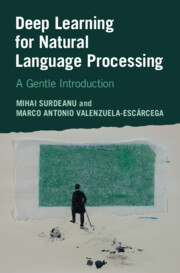Book contents
- Frontmatter
- Contents
- List of Figures
- List of Tables
- Preface
- 1 Introduction
- 2 The Perceptron
- 3 Logistic Regression
- 4 Implementing Text Classification Using Perceptron and Logistic Regression
- 5 Feed-Forward Neural Networks
- 6 Best Practices in Deep Learning
- 7 Implementing Text Classification with Feed-Forward Networks
- 8 Distributional Hypothesis and Representation Learning
- 9 Implementing Text Classification Using Word Embeddings
- 10 Recurrent Neural Networks
- 11 Implementing Part-of-Speech Tagging Using Recurrent Neural Networks
- 12 Contextualized Embeddings and Transformer Networks
- 13 Using Transformers with the Hugging Face Library
- 14 Encoder-Decoder Methods
- 15 Implementing Encoder-Decoder Methods
- 16 Neural Architectures for Natural Language Processing Applications
- Appendix A Overview of the Python Language and Key Libraries
- Appendix B Character Encodings: ASCII and Unicode
- References
- Index
16 - Neural Architectures for Natural Language Processing Applications
Published online by Cambridge University Press: 01 February 2024
- Frontmatter
- Contents
- List of Figures
- List of Tables
- Preface
- 1 Introduction
- 2 The Perceptron
- 3 Logistic Regression
- 4 Implementing Text Classification Using Perceptron and Logistic Regression
- 5 Feed-Forward Neural Networks
- 6 Best Practices in Deep Learning
- 7 Implementing Text Classification with Feed-Forward Networks
- 8 Distributional Hypothesis and Representation Learning
- 9 Implementing Text Classification Using Word Embeddings
- 10 Recurrent Neural Networks
- 11 Implementing Part-of-Speech Tagging Using Recurrent Neural Networks
- 12 Contextualized Embeddings and Transformer Networks
- 13 Using Transformers with the Hugging Face Library
- 14 Encoder-Decoder Methods
- 15 Implementing Encoder-Decoder Methods
- 16 Neural Architectures for Natural Language Processing Applications
- Appendix A Overview of the Python Language and Key Libraries
- Appendix B Character Encodings: ASCII and Unicode
- References
- Index
Summary
In this chapter, we describe several common applications (including the ones we touched on before) and multiple possible neural approaches for each. We focus on simple neural approaches that work well and should be familiar to anybody beginning research in natural language processing or interested in deploying robust strategies in industry. In particular, we describe the implementation of the following applications: text classification, part-of-speech tagging, named entity recognition, syntactic dependency parsing, relation extraction, question answering, and machine translation.
Keywords
- Type
- Chapter
- Information
- Deep Learning for Natural Language ProcessingA Gentle Introduction, pp. 246 - 271Publisher: Cambridge University PressPrint publication year: 2024

